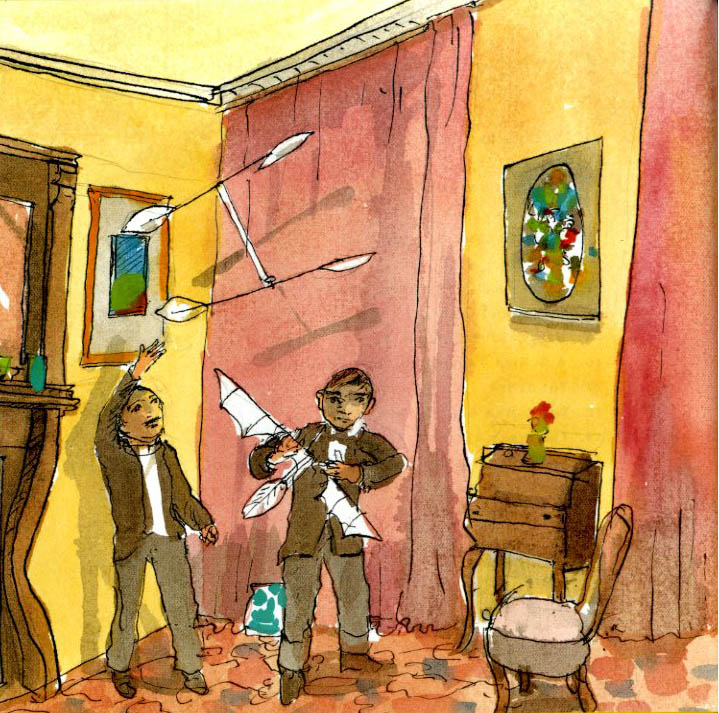
A FEW OTHER EVENTS FOR
NOVEMBER 7:
- It’s the birth date of Armstrong Sperry (1897–1976), Call It Courage.
- In 1874, Thomas Nast’s cartoon in Harper’s Weekly is the first use of an elephant as the symbol for the Republican party. Read When Elephant Goes to a Party by Sonia Levitin and Jeff Seaver.
- Duck and cover! In 1957, the Gaither Report calls for more Americans to build backyard fallout shelters. Read Gemini Summer by Iain Lawrence and Beyond Mayfield by Vaunda Micheaux Nelson.
- It’s the start of National Animal Shelter Appreciation Week (November 7–13 this year). Read Martha Speaks: Shelter Dog Blues by Susan Meddaugh.
In November we recognize National Aviation History Month. Flight and flyers have always appealed to children, and this month we’ll look at four superb books that chronicle the Age of Aviation. Let’s begin with the Wright Brothers because they made National Aviation Month possible.
There have been endless treatments and biographies of the Wrights Brothers over the years. But one of the best for second- through fourth-graders appeared in 2002, Wendie C. Old’s To Fly, containing magnificent watercolor illustrations by Robert Andrew Parker. In a forty-eight-page picture book, Old provides just enough detail to interest readers in the Wrights, without overwhelming them with too much material. She begins in Dayton, Ohio, as young Orville lay in bed at night, imagining what it would be like to swoop through the sky. Even by second grade he whittled a flying machine out of a piece of wood. He and his brother Wilbur experimented with flying kites—Orville built the best ones in Dayton and learned about how to curve wings. Although the brothers were diverted for a period of time with a printing business, they moved on to fixing bicycles and began experimenting with building gliders.
Old takes the readers through all of the Wrights’ flight attempts at Kitty Hawk, from 1900 on, to lift a glider with a rider on it. As Wilbur sails off of Kill Devil Hill, Parker’s breathtaking art shows the aviator in flight, with a magnificent panorama of the sea and sky around him. Readers cheer the brothers on as they try and try again, through periods of depression and doubt. In this brief text, the author manages to show the difficulties the brothers overcame, and how their final success rested on perseverance, tenacity, and amazing ingenuity.
A full timeline rounds out this glorious exploration of two of America’s most famous inventors. A French newspaper once asked if the Wrights were “flyers or liars.” As the author discusses in the Epilogue, these two bicycle repairmen managed to build an airplane when scientists failed to do so. In the end, they achieved their childhood dreams and became the most famous figures in aviation history.
A great story to share with the next generation of American inventors, To Fly helps readers understand Beverly McLoughland’s poem, “Crazy Boys,” which opens the book and would be an appropriate way to begin honoring National Aviation Month:
Watching buzzards,
Flying kites,
Lazy, crazy boys
The Wrights. They
Tried to fly
Just like a bird.
Foolish dreamers
Strange. Absurd. We
Scoffed and scorned
Their dreams of flight.
But we were wrong
And they were Wright.
Here’s a passage from To Fly:
 Miss Ida Palmer, Orville’s second-grade teacher, caught him fiddling with pieces of wood at his desk instead of doing classwork. Orville explained that he was making a flying machine. If it worked, he planned to build a much larger one and fly with his eleven-year-old brother.
Miss Ida Palmer, Orville’s second-grade teacher, caught him fiddling with pieces of wood at his desk instead of doing classwork. Orville explained that he was making a flying machine. If it worked, he planned to build a much larger one and fly with his eleven-year-old brother.
But the boys’ larger machine wouldn’t fly. They had not yet learned that a machine twice as big required eight times the amount of energy to move it.
Originally posted November 7, 2010. Updated for .












